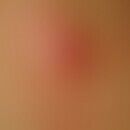DefinitionThis section has been translated automatically.
Generalized pustular figured erythema is an acute, rare, clinically severe, generalized disease that has generally been classified as AGEP in the past. More than 20 cases of GPFE due to hydroxychloroquine have been described in the medical literature.
However, generalized pustular figured erythema differs from AGEP by a delayed onset of 2 to 3 weeks (4-27 days) after initial drug exposure and by a longer persistence. It has typically been attributed to hydroxychloroquine and is more severe and difficult to treat than AGEP. There are many indications that it is probably due to a different pathogenic mechanism than the classic form of AGEP (Sidoroff A et al. 2007).
Note: This atypical course for AGEP has led to different names in the past: atypical AGEP, recurrent AGEP, pustular DRESS syndrome, AGEP/SJS overlap,16 AGEP/TEN overlap and Sweet syndrome after hydroxychloroquine (Pearson KC et al. 2016).
EtiopathogenesisThis section has been translated automatically.
Generalized pustular figured erythema can be triggered by a number of drugs. However, the association with hydroxychloroquine is emphasized. Hydroxychloroquine is commonly used to treat various rheumatic and dermatologic conditions, and has also been used as an antiviral agent for COVID-19 infections (Colson P et al. 2020; Duan YJ et al. 2020).
You might also be interested in
ClinicThis section has been translated automatically.
Clinical examination reveals an abrupt onset of pruritic exanthema, with fever and neutrophilic leukocytosis. GPFE may initially present with erythematous papules and plaques on the face with facial edema and extensive urticarial or edematous plaques scattered over the entire body, with nonfollicular pustules developing into erythematous and sometimes atypical, targeted, "erythema multiforme-like" plaques that coalesce into annular and arcuate patterns on the trunk and extremities. Pustular, erythematous plaques may develop irregularly along the active edges. Blisters or erosions are rarer. The mucous membranes are usually only slightly affected or not affected at all.
HistologyThis section has been translated automatically.
Skin biopsy specimens initially show edematous dermis but progress to subcorneal and/or intraepidermal neutrophilic pustules, sometimes with mild focal acantholysis, exocytosis, spongiosis and an edematous papillary dermis with a perivascular lymphocytic infiltrate, occasionally mixed with neutrophils, eosinophils and mast cells. Later, neutrophilic dermatitis dominates the picture. Vasculitis is not detectable.
TherapyThis section has been translated automatically.
Treatments are varied. First-line therapy consists of topical and systemic steroids. If insufficient, cyclosporine may be used. Other options include oral dapsone or etretinate.
LiteratureThis section has been translated automatically.
- Colson P et al. (2020) Chloroquine for the 2019 novel coronavirus SARS-CoV-2. Int J Antimicrob Agents 55:105923.
- Charfi O et al.(2015) Hydroxychloroquine-induced acute generalized exanthematous pustulosis with positive patch-testing. Indian J Pharmacol. 47:693-694.
- Duan YJ et al. (2020) The trial of chloroquine in the treatment of Corona Virus Disease 2019 (COVID-19) and its research progress in forensic toxicology. Fa Yi Xue Za Zhi. 36:1-1.
- Duman H et al. (2017) Acute generalized exanthematous pustulosis induced by hydroxychloroquine: a case with atypical clinical presentation. An Bras Dermatol 92: 404-406.
- Miteva L et al. (2020) Childhood acute generalized exanthematous pustulosis induced by oral ketoconazole. Acta Dermatovenerol Croat 18: 267-270.
- Pearson KC et al. (2016) Prolonged pustular eruption from hydroxychloroquine: an unusual case of acute generalized exanthematous pustulosis. Cutis 97: 212-216.
- Schwartz RA et al.(2020) Generalized pustular figurate erythema: A newly delineated severe cutaneous drug reaction linked with hydroxychloroquine. Dermatol Ther 33:e13380.
- Sidoroff A et al. (2007) Risk factors for acute generalized exanthematous pustulosis (AGEP)-results of a multinational case-control study (EuroSCAR). Br J Dermatol 157: 989-996.
- Szatkowski J et al. (2015) Acute generalized exanthematous pustulosis: a review and update. J Am Acad Dermatol 73: 843-848.
Incoming links (1)
Pustular psoriasis;Disclaimer
Please ask your physician for a reliable diagnosis. This website is only meant as a reference.








